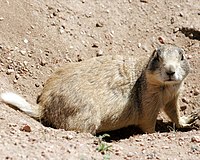White-tailed prairie dog
| White-tailed prairie dog | |
|---|---|
 |
|
| Scientific classification | |
| Kingdom: | Animalia |
| Phylum: | Chordata |
| Class: | Mammalia |
| Order: | Rodentia |
| Family: | Sciuridae |
| Genus: | Cynomys |
| Species: | C. leucurus |
| Binomial name | |
|
Cynomys leucurus (Merriam, 1890) |
|
 |
|
| White-tailed Prairie Dog range | |
The white-tailed prairie dog (Cynomys leucurus) is found in western Wyoming and western Colorado with small areas in eastern Utah and southern Montana. The largest populations are in Wyoming where they are known colloquially as "chiselers". This prairie dog species lives at an elevation between 5,000 and 10,000 feet, generally a higher elevation than other prairie dog species. Its predators include black-footed ferrets, badgers, and golden eagles.
The white-tailed prairie dog is tan-brown in color, with large eyes and a dark patch on their cheeks above and below each eye.
White-tailed prairie dog populations have decreased dramatically, and the remaining population occupies only around 8% of their original range. It is threatened by human persecution (shooting and poisoning), and a disease called Sylvatic Plague that can infect all prairie dogs. This animal lives in small communities that are vulnerable to being wiped out by all of these issues. This species appears in the IUCN Red List of Threatened Species, with a status of least concern, last assessed in 1996. Petitions have been made to protect the white-tailed prairie dog, but they have been denied by the United States Fish and Wildlife Service due to insufficient scientific data describing current population trends. This denial is being reconsidered, because former deputy assistant secretary Julie MacDonald has been found to have improperly influenced the scientific basis of the denial. Groups such as the Biodiversity Conservation Alliance are working to legally protect this species.
...
Wikipedia

